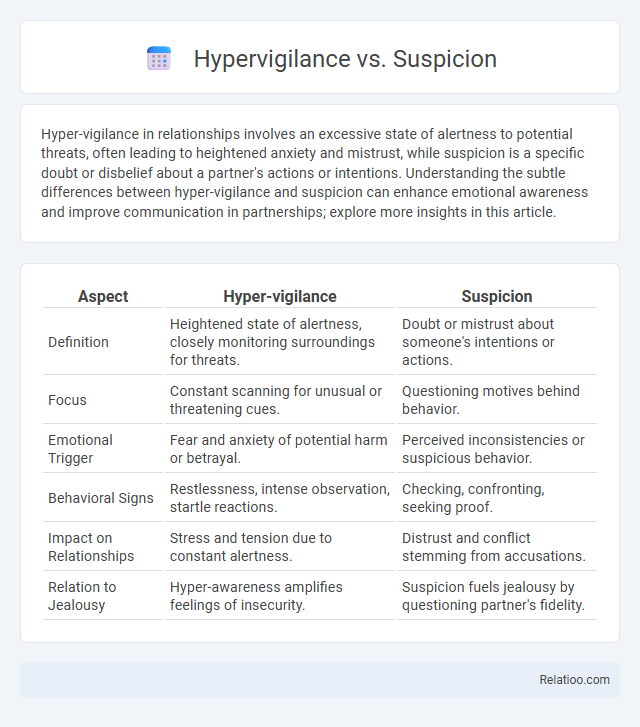Hyper-vigilance in relationships involves an excessive state of alertness to potential threats, often leading to heightened anxiety and mistrust, while suspicion is a specific doubt or disbelief about a partner's actions or intentions. Understanding the subtle differences between hyper-vigilance and suspicion can enhance emotional awareness and improve communication in partnerships; explore more insights in this article.
Table of Comparison
| Aspect | Hyper-vigilance | Suspicion |
|---|---|---|
| Definition | Heightened state of alertness, closely monitoring surroundings for threats. | Doubt or mistrust about someone's intentions or actions. |
| Focus | Constant scanning for unusual or threatening cues. | Questioning motives behind behavior. |
| Emotional Trigger | Fear and anxiety of potential harm or betrayal. | Perceived inconsistencies or suspicious behavior. |
| Behavioral Signs | Restlessness, intense observation, startle reactions. | Checking, confronting, seeking proof. |
| Impact on Relationships | Stress and tension due to constant alertness. | Distrust and conflict stemming from accusations. |
| Relation to Jealousy | Hyper-awareness amplifies feelings of insecurity. | Suspicion fuels jealousy by questioning partner's fidelity. |
Understanding Hyper-vigilance and Suspicion
Hyper-vigilance is an intense state of sensory sensitivity and constant scanning for threats, often linked to anxiety or trauma, which can overwhelm Your ability to relax or focus. Suspicion involves a cautious mindset or doubt about someone's intentions, typically based on observed evidence or behavior rather than an uncontrollable urge. Understanding the difference between hyper-vigilance and suspicion helps in recognizing when heightened alertness is adaptive versus when it becomes debilitating or irrational.
Defining Key Differences
Hyper-vigilance involves an intense state of sensory sensitivity and constant scanning of the environment for potential threats, often linked to anxiety disorders or trauma. Suspicion refers to a cautious or mistrustful attitude towards others or situations, based on specific doubts rather than an overwhelming sense of threat. Your understanding of these distinctions helps in recognizing when heightened alertness shifts from adaptive caution to a debilitating psychological condition.
Causes of Hyper-vigilance
Hyper-vigilance often stems from trauma, anxiety disorders, or chronic stress, causing heightened sensory sensitivity and constant environmental scanning. Unlike suspicion, which is a rational distrust based on specific stimuli or evidence, hyper-vigilance is an exaggerated state of alertness without clear threats. Your brain's survival mechanism becomes overactive, resulting in heightened awareness that can disrupt daily functioning and lead to exhaustion.
What Triggers Suspicion?
Suspicion is often triggered by inconsistencies in behavior, unfamiliar situations, or perceived threats that challenge your expectations or safety. Unlike hyper-vigilance, which is a heightened and continuous state of alertness often linked to anxiety or trauma, suspicion involves a focused doubt or mistrust toward specific stimuli or individuals. Your brain's natural protective mechanisms activate suspicion to evaluate and respond to potential risks in your environment.
Psychological Impact of Both States
Hyper-vigilance, characterized by an excessive state of sensory sensitivity and constant scanning for threats, often results in chronic stress, anxiety, and impaired cognitive functioning due to heightened arousal in the amygdala and prefrontal cortex. Suspicion, a cognitive state involving doubt and mistrust without the intense physiological activation seen in hyper-vigilance, tends to foster social isolation and paranoia but may not consistently trigger severe stress responses. Both states significantly affect mental health, with hyper-vigilance linked to post-traumatic stress disorder (PTSD) and anxiety disorders, whereas persistent suspicion can exacerbate feelings of alienation and contribute to chronic interpersonal difficulties.
Behavioral Signs to Recognize
Behavioral signs of hyper-vigilance include constant scanning of the environment, heightened startle responses, and difficulty relaxing, reflecting an intense state of alertness often linked to trauma. Suspicion manifests through consistent doubt, mistrust of others' intentions, and hesitance to share personal information, indicating a guarded mindset rather than an overactive threat detection system. Recognizing these distinctions helps You differentiate between hyper-vigilance's heightened sensory awareness and suspicion's cognitive mistrust, crucial for addressing underlying causes effectively.
Hyper-vigilance in Trauma and PTSD
Hyper-vigilance in trauma and PTSD involves an enhanced state of sensory sensitivity and an exaggerated scanning of the environment for potential threats, which is distinct from general suspicion characterized by baseline distrust or doubt towards others. Unlike suspicion, hyper-vigilance is a pathological response linked to traumatic stress, leading to heightened arousal, difficulty concentrating, and impaired daily functioning. This symptom is a core feature of PTSD, contributing to persistent anxiety and a disrupted sense of safety after experiencing or witnessing traumatic events.
Suspicion in Everyday Relationships
Suspicion in everyday relationships often stems from mistrust or past experiences and can lead to constant doubt about others' intentions, negatively impacting communication and emotional connection. Unlike hyper-vigilance, which involves an exaggerated awareness of potential threats, suspicion is more focused on questioning the honesty or loyalty of those around you. Managing suspicion effectively requires cultivating open dialogue and reinforcing trust to prevent it from escalating into paranoia or hyper-vigilance.
Managing and Coping Strategies
Managing hyper-vigilance involves grounding techniques and structured routines to reduce overwhelming alertness, while suspicion requires cognitive-behavioral strategies to challenge irrational beliefs and promote trust-building. Coping with hyper-vigilance centers on mindfulness practices, controlled breathing, and sensory modulation to alleviate anxiety and restore calm. Effective stress management, psychoeducation, and therapy tailored to each state enhance emotional regulation and improve overall mental well-being.
Seeking Professional Help
Hyper-vigilance involves an excessive state of heightened alertness, while suspicion centers on doubting others' intentions without constant anxiety. Recognizing these patterns is crucial for your mental health, as persistent hyper-vigilance or suspicion can impair daily functioning and relationships. Seeking professional help from a mental health specialist can provide tailored strategies and support to manage these symptoms effectively.

Infographic: Hyper-vigilance vs Suspicion
 relatioo.com
relatioo.com